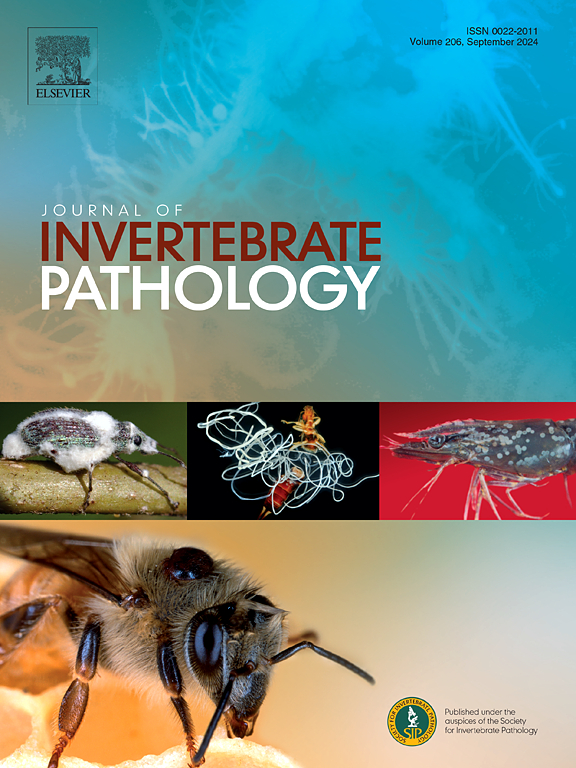Biosynthesis of silver nanoparticles using soil actinobacterium Streptomyces anthocyanicus and investigation of their larvicidal potentials against Culex quinquefasciatus Aedes aegypti, and Anopheles stephensi
IF 2.4
3区 生物学
Q1 ZOOLOGY
引用次数: 0
Abstract
Mosquitoes represent a considerable risk to human health due to their role in transmitting various pathogens responsible for diseases like chikungunya, malaria, dengue, and Japanese encephalitis. There is an immediate necessity to explore innovative biological strategies to combat mosquito-borne illnesses. One promising avenue in current research is the development of bioinsecticides utilizing advanced nanotechnology. Therefore, this study aimed to synthesize silver nanoparticles from the actinobacterial strain Streptomyces anthocyanicus (OR186732), isolated from the Western Ghats in Tamil Nadu, India. The AgNPs were synthesized and then characterized using UV–visible spectroscopy, identifying a prominent absorption peak at 424 nm. The identification of different functional groups within the AgNPs was confirmed through FTIR. The produced AgNPs were shown to be crystalline by XRD analysis. The nanoparticles were characterized using FESEM, HRTEM, and EDX to analyze their morphology, size, and elemental composition. The stability was assessed through Zeta potential measurements, which were measured at −0.2 mV. The synthesized AgNPs showed strong larvicidal effects against Culex quinquefasciatus (LC50 = 2.924 ppm), Aedes aegypti (LC50 = 3.245 ppm), and Anopheles stephensi (LC50 = 3.767 ppm). Furthermore, the AgNPs were observed to significantly increase the levels of antioxidant enzymes such as SOD and GPx at high concentrations. In contrast, levels of detoxifying enzymes such as AChE and GST levels were reduced. Histological analysis of mosquito larvae treated with AgNPs revealed significant damage to the midgut tissues. The research suggests that AgNPs synthesized by Actinobacteria could be an environmentally friendly option for biological mosquito control.

利用土壤放线菌花青素链霉菌合成纳米银及其对致倦库蚊、埃及伊蚊和斯氏按蚊的杀幼虫活性研究。
蚊子对人类健康构成相当大的风险,因为它们在传播引起基孔肯雅热、疟疾、登革热和日本脑炎等疾病的各种病原体方面发挥着作用。迫切需要探索创新的生物学策略来对抗蚊子传播的疾病。利用先进的纳米技术开发生物杀虫剂是目前研究的一个有前途的途径。因此,本研究旨在从来自印度泰米尔纳德邦西高特山脉的放线菌花青菌链霉菌(OR186732)中合成纳米银。合成了AgNPs,并用紫外可见光谱对其进行了表征,在424 nm处发现了一个显著的吸收峰。通过FTIR证实了AgNPs中不同官能团的鉴定。经XRD分析,所得AgNPs呈结晶状。利用FESEM、HRTEM和EDX对纳米颗粒进行了表征,分析了它们的形态、大小和元素组成。通过Zeta电位测量来评估稳定性,Zeta电位在-0.2 mV下测量。合成AgNPs显示强大的杀灭幼虫的影响对这种致倦库蚊(LC50 = 2.924 ppm),埃及伊蚊(LC50 = 3.245 ppm),并按蚊stephensi (LC50 = 3.767 ppm)。此外,AgNPs在高浓度下可显著提高抗氧化酶如SOD和GPx的水平。相反,解毒酶如AChE和GST水平降低。用AgNPs处理的蚊子幼虫的组织学分析显示对中肠组织有明显的损伤。该研究表明,放线菌合成的AgNPs可能是一种环境友好的生物蚊虫控制选择。
本文章由计算机程序翻译,如有差异,请以英文原文为准。
求助全文
约1分钟内获得全文
求助全文
来源期刊
CiteScore
6.10
自引率
5.90%
发文量
94
审稿时长
1 months
期刊介绍:
The Journal of Invertebrate Pathology presents original research articles and notes on the induction and pathogenesis of diseases of invertebrates, including the suppression of diseases in beneficial species, and the use of diseases in controlling undesirable species. In addition, the journal publishes the results of physiological, morphological, genetic, immunological and ecological studies as related to the etiologic agents of diseases of invertebrates.
The Journal of Invertebrate Pathology is the adopted journal of the Society for Invertebrate Pathology, and is available to SIP members at a special reduced price.

 求助内容:
求助内容: 应助结果提醒方式:
应助结果提醒方式:


